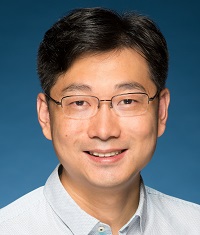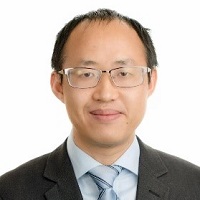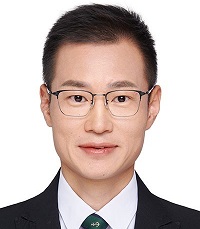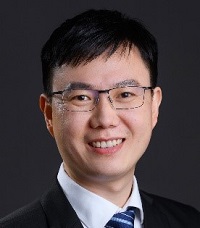ICICSP Keynote Speaker

Prof. Xiaowen Chu, The Hong Kong University of Science and Technology (Guangzhou), China
Fellow, IEEE
Professor Xiaowen Chu is a Full Professor and Acting Head of the Artificial Intelligence Thrust at The Hong Kong University of Science and Technology (Guangzhou). He has been the Head of Data Science and Analytics Thrust at HKUST(GZ) during 2023-2025. He received his Bachelor’s degree from Tsinghua University and his Ph.D. from The Hong Kong University of Science and Technology. His research focuses on high-performance computing, machine learning systems, and distributed systems. He has received seven Best Paper Awards at international conferences, including the CCF-A ranked conferences EuroSys 2025 and INFOCOM 2021, and Distinguished Paper Award of ICDCS 2025. Professor Chu has been recognized multiple times in the Stanford University World’s Top 2% Scientists List. He serves (or has served) as an Associate Editor or Guest Editor for SCI-indexed journals such as IEEE Transactions on Cloud Computing, IEEE Transactions on Network Science and Engineering, IEEE Internet of Things Journal, IEEE Transactions on Big Data, IEEE Network, and IEEE Transactions on Industrial Informatics. He was the TPC Co-Chair or General Co-Chair of IEEE MetaCom 2025, IEEE/ACM IWQoS 2024, BigCom 2023, IEEE GreenCom 2022, IEEE HPCC 2021, IEEE DSS 2020, EAI QShine 2019, etc. For his contributions to algorithms for communication-efficient distributed machine learning, he was elected as an IEEE Fellow (Class of 2025).
Speech Title: Accelerating Large Mixture-of-Experts Models via Pipelining and Scheduling
Abstract: In recent years, large-scale deep neural network models can be easily scaled to trillions of parameters with sparsely activated mixture-of-experts (MoE), which significantly improves the model quality while only requiring a sub-linear increase in computational costs. However, the dynamic activation of MoE experts introduces extensive communications, limiting the scaling efficiency of distributed systems. In this talk, we will first provide an overview of sparsely activated MoE and its training challenges, and then present some of our recent work on improving the training efficiency of MoE-based LLM models, which leverages two simple ideas: pipelining and scheduling.

Prof. Yong Zeng, Southeast University, China
Fellow, IEEE
Yong Zeng, IEEE Fellow, young chief professor of Southeast University and Purple Mountain Laboratory, national youth high-level talent, Jiangsu province entrepreneurship and innovation talent, “6G Rising Star” Young Scholar of Global 6G Conference 2024, Clarivate Analytics Highly Cited Researcher for 6 consecutive years (2019-2024), AI2000 Most Influential Scholars in the field of Internet of Things for 4 consecutive years (2021-2024), and Elsevier Most Cited Chinese Researcher for 4 consecutive years (2021-2024). Prof. Zeng has enlisted as the Stanford "Top 2% of Scientists in the World - Lifetime Influence" list. He is the recipient of Australia Research Council (ARC) Discovery Early Career Researcher Award (DECRA), IEEE Communications Society Asia-Pacific Outstanding Young Researcher Award, and won 8 international and domestic best paper awards including IEEE Marconi Award (2020 and 2024), Heinrich Hertz Award (2017 and 2020), etc. He proposed the concept of channel knowledge map (CKM) and the novel transmission method of Delay-Doppler alignment modulation (DDAM). His works have been cited by more than 31,000 times. He serves on the editorial board of SCI journals such as IEEE Transactions on Communications, IEEE Transactions on Mobile Computing, and IEEE Communications Letters, and leading guest editor of journals including IEEE ComMag, Wireless ComMag, China Communications, and Science China Information Sciences. He was elevated to IEEE Fellow “for contributions to unmanned aerial vehicle communications and wireless power transfer”.
Speech Title: Low-Altitude UAV ISAC based on Ray Antenna Array
Abstract: Most existing MIMO wireless communication and sensing systems rely on fully-digital or phase shifter-based hybrid analog/digital beamforming architectures, which face critical challenges in high-frequency systems, such as difficulty to implement and poor control accuracy for phase shifters. To address such challenges, this talk will introduce a new MIMO architecture based on the novel ray antenna array (RAA). RAA consists of a large number of low-cost antenna elements, which are arranged in a ray-shaped structure with deliberately designed orientations, thus achieving efficient beam steering without relying on conventional analog or digital beamforming techniques. Compared with the traditional MIMO architecture, RAA system has several appealing advantages, including significantly reduced hardware costs and power consumption, achieving uniform angular resolution in all signal directions, and enhanced beaming gain by enabling antenna elements with higher directivity. Thus, RAA has a wide range of applications in future wireless communications and sensing systems. This talk will first introduce the new MIMO architecture based on RAA, explain its array design and beamforming mechanism in two-dimensional and three-dimensional space, and explore its spatial resolution characteristics. Finally, it will introduce the theories and methods of RAA-based integrated sensing and communication (ISAC) for low-altitude unmanned aerial vehicles (UAVs).

Prof. Guan Gui, Nanjing University of Posts and Telecommunications, China
Fellow, IEEE
Guan Gui (Fellow, IEEE) received his Ph.D. degree from the University of Electronic Science and Technology of China, Chengdu, China, in 2012. From 2009 to 2014, he was a research assistant and postdoctoral research fellow at Tohoku University, Japan. From 2014 to 2015, he was an Assistant Professor at Akita Prefectural University in Japan. Since 2015, he has been a Professor at Nanjing University of Posts and Telecommunications, China. His research focuses on intelligent sensing and recognition, intelligent signal processing, and physical layer security. Dr. Gui has authored over 200 IEEE journal and conference papers and received several best paper awards, including at ICC 2017, ICC 2014, and VTC 2014-Spring. He is a fellow of IEEE, IET, and AAIA, and he is recognized for his contributions to intelligent signal analysis and wireless resource optimization. Among his accolades, he received the IEEE Communications Society Heinrich Hertz Award in 2021 and was named a Clarivate Analytics Highly Cited Researcher from 2021 to 2024. Dr. Gui is a Distinguished Lecturer for the IEEE Vehicular Technology Society (VTS) and the IEEE Communications Society (ComSoc). He is an editorial board member for several leading journals, including the IEEE Transactions on Information Forensics and Security, IEEE Internet of Things Journal, and IEEE Transactions on Vehicular Technology. Additionally, he serves as the Editor-in-Chief of KSII Transactions on Internet and Information Systems. He has also held prominent roles in international conferences, such as Executive Chair of IEEE ICCT 2023, Executive Chair of VTC 2021-Fall, and Vice Chair of WCNC 2021.
Speech Title: Intelligent Signal Sensing and Recognition for 6G Physical Layer Security
Abstract: The advent of 6G wireless communication marks a paradigm shift toward intelligent, secure, and pervasive connectivity. In this keynote, we explore how Artificial Intelligence (AI) and Deep Learning (DL) are revolutionizing physical-layer security through advanced signal sensing and recognition techniques. As 6G systems encounter increasingly dynamic environments, traditional model-based approaches struggle with complex interference patterns and uncertain channel conditions. To address these challenges, we highlight the role of neural networks in enhancing signal detection, classification, and Specific Emitter Identification (SEI). Through gradient-based optimization and data-driven learning, AI-enabled frameworks can significantly improve model adaptability and accuracy, outperforming conventional rule-based methods. Moreover, we examine how DL is reshaping baseband module functionalities—including modulation recognition, coding/decoding, and detection—toward greater robustness and efficiency. This keynote underscores the strategic importance of integrating intelligent signal processing with next-generation communication systems. By embedding AI into the physical layer, we can build resilient, secure, and intelligent wireless infrastructures capable of meeting the stringent demands of future 6G applications.

Prof. Zai Yang, Xi'an Jiaotong University, China
Zai Yang is a Professor of the School of Mathematics and Statistics, Xi'an Jiaotong University, China. He received the B.Sc. degree in mathematics and M.Sc. degree in applied mathematics from Sun Yat-sen (Zhongshan) University, China, in 2007 and 2009 respectively, and the Ph.D degree in electrical and electronic engineering from Nanyang Technological University (NTU), Singapore, in 2014. His research interest is focused on mathematical foundations of signal processing and wireless communications. He has resolved long-standing open problems such as the high-dimensional analog of the Carathéodory-Fejér theorem and the determination of positive definiteness of the Hadamard product of singular positive-semidefinite matrices. He has published over 70 academic papers in top-tier journals and conferences such as IEEE T-IT, IEEE T-SP, ACHA and SIMAX, receiving more than 4400 citations according to Google Scholar. He was a leading tutorial presenter at EUSIPCO 2017. He is an Associate Editor of IEEE Trans. Signal Processing (2023-), a Handling Editor of (Elsevier) Signal Processing (2017-), a member of the Sensor Array and Multichannel (SAM) Technical Committee (TC) of the IEEE Signal Processing Society (2023-2025), and an IEEE senior member (2019-). He was awarded the NSFC Excellent Youth Science Foundation Grant in 2019.
Speech Title: The Carathéodory-Fejér Theorem and Spectral Analysis of Signals
Abstract: Spectral analysis of signals is a core component of modern information techniques. The rapid developments of radar detection and wireless communications have advanced its research from fast Fourier transform (FFT) in the 1960s to subspace methods emerging in the 1970s, and then to sparse and compressed sensing methods of this century. In this talk, we revisit the Carathéodory-Fejér Theorem (1911) on Vandermonde decomposition of Toeplitz covariance matrices and discuss its key role in spectral analysis of the past half century. We emphasize our extension of the Carathéodory-Fejér Theorem from 1-D to high dimensions and show how it forms the basis of previous (subspace and compressed sensing) approaches and innovates novel (signal-domain maximum likelihood and deep learning) methods for spectral analysis.
